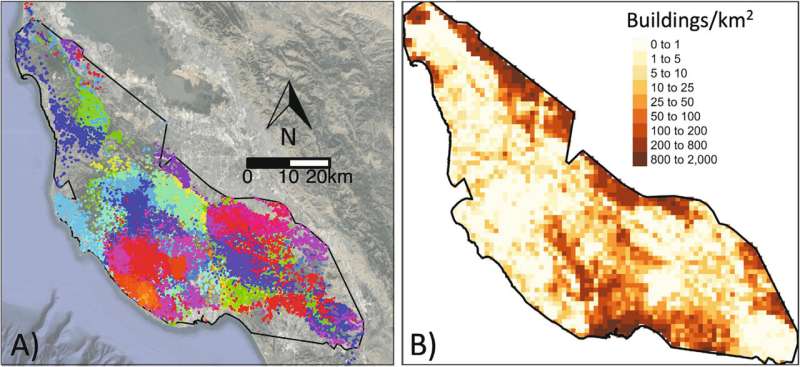This article has been reviewed according to Science X's editorial process and policies. Editors have highlighted the following attributes while ensuring the content's credibility:
fact-checked
peer-reviewed publication
trusted source
proofread
Humans and housing density are the leading cause of death for local pumas, find researchers

Two new studies involving UC Santa Cruz researchers are shedding light on the challenges facing local pumas where humans are encroaching on their natural habitats.
Anna Nisi, a former graduate researcher for the Santa Cruz Puma Project, examined 11 years of research regarding the movement, mortality, and reproductive data for 67 pumas in the Santa Cruz mountains for a paper that recently appeared in Ecological Applications. The study looked at how exposure to human development impacted puma survival and population dynamics.
Nisi's research found that pumas who live in areas with more human development have lower survival rates, with female pumas being more affected than males. Female pumas have an 18% decrease in survival rates in areas with higher human development. This has consequences for puma population dynamics—in other words, whether we can expect the puma population to increase or decrease over time.
"This study shows that minimizing further development in remote areas that are high-quality habitats for pumas is really important to make sure that the puma population can continue to live here into the future," said Nisi.
Because adult female pumas do more poorly in areas with more human development, these places can't support puma population growth. Much of the study area—42%—fits that description. While this study estimates that the Santa Cruz Mountain puma population is stable, further development in remote areas could tip the balance and lead to a population decline. This study underscores that high-quality, remote habitats in the Santa Cruz Mountains should be protected for long-term puma population persistence.

A second paper published in PNAS, that Nisi and environmental studies professor Chris Wilmers co-authored with John Benson from the University of Nebraska-Lincoln, looked at broad-scale patterns of survival and human-caused mortality for pumas in California. (Pumas are also referred to locally as mountain lions.) The PNAS study, which studied 590 mountain lions in 23 areas across California, including Santa Cruz, found that mountain lions were at greater risk of mortality from humans when they were closer to rural development. This study also found that human-caused mortality is additive to mortality from natural sources.
One of the contributing factors is the Wildland Urban Interface (WUI), which has greatly impacted puma mortality, according to environmental studies professor Chris Wilmers, who leads the Puma Project. The Wildland Urban Interface (WUI) is the area where human development and wildland vegetation meet, and in recent years it has expanded rapidly due to population growth and land use policies.
"Chronic exposure to housing increases mortality risk in pumas, and that goes to how we've developed the landscape as a society," Wilmers said. "The WUI has been super lethal to our wildlife and has become a major environmental problem."
The PNAS study found that while mountain lions have been protected from hunting, conflict with humans over livestock and collisions with vehicles also contribute to their mortality. The study's results speak to the need for greater puma conservation efforts in human-dominated areas, said Wilmers, as well as the need to protect puma habitats and manage human development to minimize their impact on pumas in the future.
More information: Anna C. Nisi et al, Habitat fragmentation reduces survival and drives source–sink dynamics for a large carnivore, Ecological Applications (2023). DOI: 10.1002/eap.2822
Journal information: Proceedings of the National Academy of Sciences , Ecological Applications
Provided by University of California - Santa Cruz




















